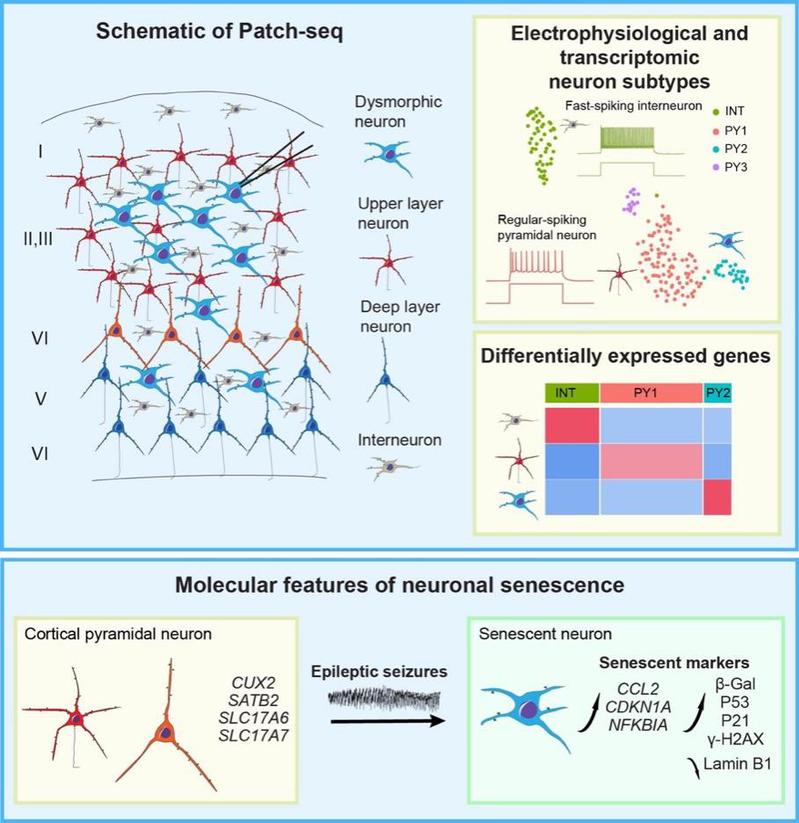CHEN Jiadong' group published in Journal of Clinical Investigation on molecular markers of neuronal senescence in human drug-resistant epilepsy
Epilepsy is a chronic neurological disorder caused by abnormal discharges of neurons in the brain and is often accompanied by symptoms such as cognitive impairment, anxiety, depression, and autism, severely affecting patients' quality of life. Globally, approximately 70 million people suffer from epilepsy, with an incidence rate of about 6.4 per 1,000 people. Among them, around 30% do not respond to existing antiepileptic drugs and are classified as "drug-resistant epilepsy," though its exact pathogenesis remains unclear. Studies have shown distinct pathological characteristics from the epileptic focus of brain tissue of patients with drug-resistant epilepsy. For example, patients with focal cortical dysplasia (FCD) epilepsy have dysmorphic neurons in the gray matter and balloon cells in the white matter, whereas patients with temporal lobe epilepsy (TLE) display neuronal loss and hippocampal sclerosis. Understanding the gene expression characteristics of these pathological neuronal cells is crucial for investigating the diagnosis and pathogenesis of drug-resistant epilepsy.

Dr. Jiadong Chen’s group at Zhejiang University published an article online in the Journal of Clinical Investigation titled “Multimodal single-cell analyses reveal molecular markers of neuronal senescence in human drug-resistant epilepsy”on March 3, 2025. The study utilized Patch-seq, a technique combining patch-clamp electrophysiology with single-cell sequencing, to precisely analyze the electrophysiological properties, morphology, and gene expression of pathological neurons in drug-resistant epilepsy. We identified a unique subpopulation of cortical pyramidal neurons that highly express genes associated with the mTOR pathway, inflammatory responses, and cellular senescence, such as CDKN1A (P21)、CCL2 and NFKBIA. Furthermore, pathological neurons in the brain tissue of drug-resistant epilepsy patients exhibited increased expression of senescence markers (P21、P53、COX2、γ-H2AX、β-Gal)and a reduction in the nuclear integrity marker Lamin B1. These changes were observed in the brain tissue of drug-resistant epilepsy across different pathologies, but were absent in control brain tissues from individuals without epilepsy. Additionally, in a mouse model of drug-resistant epilepsy, we found that chronic seizures—rather than acute seizures—induced the expression of cortical neuronal senescence markers, further supporting the role of neuronal senescence in epilepsy pathogenesis.
Professor Gemma L. Carvill from Northwestern University positively acknowledged our work in JCI: "Neuronal senescence is prevalent in aging as well as in neurodegenerative disease. However, a role for senescence in epilepsy is virtually unexplored. In this issue of the JCI, Ge and authors used resected brain tissue from individuals with drug-resistant epilepsy, a genetic knockout mouse model, and a chemoconvulsant mouse model, to demonstrate a subset of cortical pyramidal senescent neurons that likely contribute to the pathophysiology of epilepsy. These findings highlight senescence as a possible target in precision-therapy approaches for epilepsy and warrant further investigation."

Figure 1. Patch-seq reveals the morphological, electrophysiological and molecular markers of pathological neurons in drug-resistant epilepsy
This study was jointly conducted by Ph.D. students Qianqian Ge, Jiachao Yang (currently a postdoctoral researcher at the Department of Brain Science and Brain Medicine, Zhejiang University), Fei Huang, Xinyue Dai, and Chao Chen, in collaboration with Professor Li Shen’s laboratory at Zhejiang University and Professor Shengjin Xu’s laboratory at the Institute of Neuroscience, Center for Excellence in Brain Science and Intelligence Technology, Chinese Academy of Sciences. The study also received valuable support from the teams of Professors Shumin Duan, Xiaoming Li, Jianmin Zhang, and Junming Zhu at Zhejiang University, as well as the National Health and Disease Human Brain Tissue Resource Bank.
The Jiadong Chen's group at Zhejiang University School of Medicine is dedicated to functional genomics research in neuroscience by integrating single-cell genomics, calcium imaging, and electrophysiology. Recent research findings have been published in international journals including Journal of Clinical Investigation (2025), Nature Communications (2025, accepted), Advanced Science (2024), and Neuroscience Bulletin (2022, 2023). Our lab is currently recruiting postdoctoral researchers interested in neurobiology, cell biology, and genomics, offering competitive benefits. Interested candidates are invited to send their CV and research interests to jardongchen@zju.edu.cn.

Related paper:https://www.jci.org/articles/view/188942 (doi: 10.1172/JCI188942)
Comment by Professor Gemma L. Carvill: https://www.jci.org/articles/view/189519







